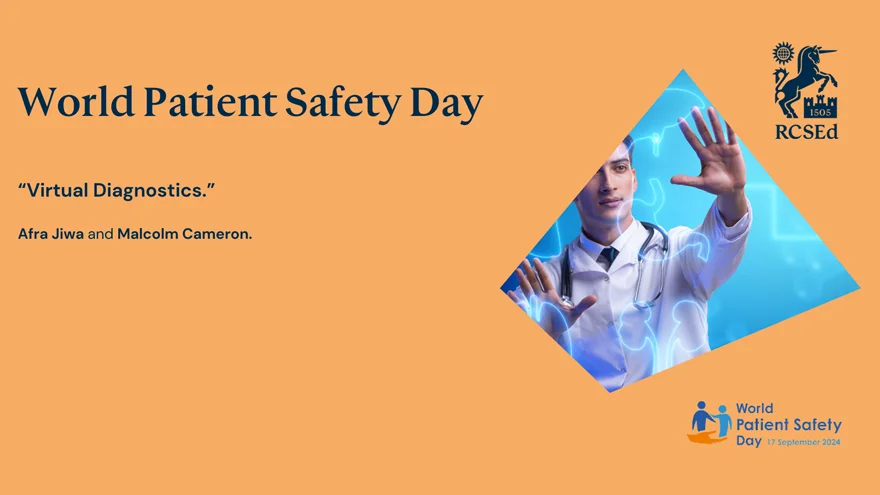
The Patient Safety Group (PSG) of the Royal College of Surgeons of Edinburgh (RCSEd) are delighted to lend our enthusiastic support to the sixth World Patient Safety Day (WPSD). This event, established by the World Health Organisation (WHO) in 2019, takes place on 17 September every year. It helps to raise global awareness amongst all stakeholders about key Patient Safety issues and foster collaboration between patients, health care workers, health care leaders and policy makers to improve patient safety. Each year a new theme is selected to highlight a priority patient safety area for action.
The theme set by the WHO for this year’s WPSD is “Improving diagnosis for patient safety”, recognising the vital importance of correct and timely diagnosis in ensuring patient safety and improving health outcomes.
Failure to rescue, a term used to describe the inability to detect and manage postoperative complications promptly, remains a significant cause of preventable morbidity and mortality (1). While patient and disease factors partially explain avoidable death after surgery, health system factors such as the use of postoperative monitoring, emergent imaging, and critical care facilities are key to rescuing patients from major complications (2).
Death following surgery is due to bleeding, sepsis, or a myocardial injury in almost half of instances (3). Prompt identification and management of these complications promises reductions in avoidable mortality. Failure to recognise deterioration in a timely manner is common.
Close monitoring in the early postoperative period is important, given the median time from surgery to major bleeding (day of surgery, interquartile range 0–2), myocardial injury (day 1, IQR 0–1) and sepsis (day 6, IQR 3–11).
In the current standard of care in the UK, detection of a deteriorating patient relies on healthcare staff to intermittently take a set of observations which is used to calculate a National Early Warning Score (NEWS) (4). This will then trigger an escalation pathway to intervention. Failures in this sequence are common – this may occur due to information lost through intermittent observation (5), inaccurate detection and documentation of a set of clinical observations(6), or failure to escalate appropriately(7).
Innovation in this area relates to ways in which this process can be automated and reduce both the burden on staff and the risks associated with human error. This level of automated continuous monitoring already exists in high-risk environments, like the Intensive care unit, but owing to financial and staffing limitations this is currently not translatable to the everyday ward environment where most fatal deteriorations go undetected.
To address these challenges, advances in remote monitoring and virtual diagnostics are emerging - which focus on the utility of wireless wearable devices and real-time analysis. One such advancement is the Enhanced Monitoring Using Sensors after surgery (EMUs) study, launched in Edinburgh earlier this year. The study, funded by Wellcome Leap, looks to monitor patients after surgery and can be performed using any suitable wearable device (it is device agnostic), as it seeks to gather generalisable information. In the first instance, we will use the Sibel ANNE® One device. ANNE® One is a wireless ICU-grade dual sensor system that provides real-time physiological monitoring. The system features two skin-mounted, bio-integrated sensors that provide continuous storage of vital sign measurements and physiological waveforms.
These devices, which will continuously detect a patient’s heart rate, respiratory rate, oxygen saturation and skin temperature, will allow for cost-effective real time analysis of patient observations. The data from several patients could be reviewed by a single member of staff and would allow detection of second-to-second variations in patient observations, which might be suggestive of deterioration. Superimposing AI algorithms onto this data would also allow for predictive models which could create early alerts for patients on the cusp of deteriorating. You can read more about the use of AI for diagnostics in our other blog post.
The primary aim of the EMUs study is to determine if data from wearable physiological monitors can be used for the early detection of postoperative deterioration – and subsequent analysis should allow us to highlight the potential of virtual remote diagnostics and the lifesaving role it can play in improving patient outcomes after surgery. The study which will be running at the Royal Edinburgh Infirmary and Solihull hospital, will also be run at hospitals across our partner hub sites in India, Rwanda, Benin, Ghana, Nigeria, Mexico and Guatemala. These partnerships will provide a more nuanced insight into the utility of remote diagnostics, not just in the UK, but across diverse and variably resourced contexts as well. This global perspective is crucial as we work toward a future where healthcare is more equitable for all – by harnessing the power of digital technologies like remote diagnostics, we can develop scalable solutions that address preventable mortality and morbidity, ultimately improving healthcare outcomes worldwide.
Written by Afra Jiwa and Malcolm Cameron
References
- Ghaferi AA, Birkmeyer JD, Dimick JB. Variation in hospital mortality associated with inpatient surgery. N Engl J Med. 2009;361(14):1368-1375. doi:10.1056/NEJMsa0903048
- Knight SR, Shaw CA, Pius R, et al. Global variation in postoperative mortality and complications after cancer surgery: a multicentre, prospective cohort study in 82 countries. The Lancet. 2021;397(10272):387-397. doi:10.1016/S0140-6736(21)00001-5
- Vascular Events in Noncardiac Surgery Patients Cohort Evaluation (VISION) Study Investigators, Spence J, LeManach Y, et al. Association between complications and death within 30 days after noncardiac surgery. CMAJ. 2019;191(30):E830-E837. doi:10.1503/cmaj.190221
- National Early Warning Score (NEWS) 2. RCP London. December 19, 2017. Accessed April 3, 2024. https://www.rcplondon.ac.uk/projects/outputs/national-early-warning-score-news-2
- Downey CL, Chapman S, Randell R, Brown JM, Jayne DG. The impact of continuous versus intermittent vital signs monitoring in hospitals: A systematic review and narrative synthesis. International Journal of Nursing Studies. 2018;84:19-27. doi:10.1016/j.ijnurstu.2018.04.013
- Hogan J. Why don’t nurses monitor the respiratory rates of patients? Br J Nurs. 2006;15(9):489-492. doi:10.12968/bjon.2006.15.9.21087
- Johnston MJ, Arora S, King D, et al. A systematic review to identify the factors that affect failure to rescue and escalation of care in surgery. Surgery. 2015;157(4):752-763. doi:10.1016/j.surg.2014.10.017

